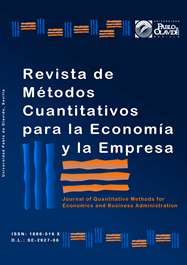Short-term impact of COVID-19 on financial system in a dollarized economy
DOI:
https://doi.org/10.46661/revmetodoscuanteconempresa.5556Keywords:
COVID-19, lockdown, financial system, regression discontinuity, EcuadorAbstract
This paper analyzes the short-term impact of the lockdown policies implemented to stop the spread of the COVID-19 on the Ecuadorian financial system. We use a regression discontinuity in time (RDiT) design jointly with official data. Results show an overall decrease in total deposits (-3.4%) as well as in credits targeted to private sector (-0.60%). In addition, we find heterogeneous results across the different types of credits and deposits being the most affected those related to public institutions.
Downloads
References
Albulescu, C.T. (2021). Covid-19 and the United States financial markets’ volatility. Finance Research Letters, 38, 101699. https://doi.org/10.1016/j.frl.2020.101699
Anderson, M. L. (2014). Subways, strikes, and slowdowns: The impacts of public transit on traffic congestion. American Economic Review, 104(9), 276-396. https://doi.org/10.1257/aer.104.9.2763
Atalan, A. (2020). Is the lockdown important to prevent the covid-19 pandemic? Effects on psychology, environment and economy-perspective. Annals of Medicine and Surgery, 56, 38-42. https://doi.org/10.1016/j.amsu.2020.06.010
Auffhammer, M., & Kellogg, R. (2011). Clearing the air? The effects of gasoline content regulation on air quality. American Economic Review, 101(6), 2687-2722. https://doi.org/10.1257/aer.101.6.2687
Barnes, S. R., Beland, L.-P., Huh, J., & Kim, D. (2020). The effect of covid-19 lockdown on mobility and traffic accidents: Evidence from Louisiana (Working paper). GLO Discussion Paper. Retrieved from https://www.econstor.eu/handle/10419/222470
Bastos, R., & Pindado, J. (2013). Trade credit during a financial crisis: A panel data analysis. Journal of Business Research, 66(5), 614-620. https://doi.org/10.1016/j.jbusres.2012.03.015
Beck, T. (2020). Finance in the times of coronavirus. Economics in the Time of COVID-19, 73-76.
Camino-Mogro, S. (2020). Turbulence in startups: Effect of covid-19 lockdown on creation of new firms and its capital (Working Paper). Retrieved from https://mpra.ub.uni-muenchen.de/ 104502/1/MPRA paper 104502.pdf
Cattaneo, M., Idrobo, N., & Titiunik, R. (2020). A Practical Introduction to Regression Discontinuity Designs: Foundations (Elements in Quantitative and Computational Methods for the Social Sciences). Cambridge: Cambridge University Press. https://doi.org/10.1017/9781108684606
Dang, H.-A., & Trinh, T.-A. (2021). Does the covid-19 lockdown improve global air quality? New cross-national evidence on its unintended consequences. Journal of Environmental Economics and Management, 105, 102401. https://doi.org/10.1016/j.jeem.2020.102401
Engelhardt, N., Krause, M., Neukirchen, D., & Posch, P. (2020). What drives stocks during the corona-crash? News attention vs. rational expectation. Sustainability, 12 (12), 5014. https://doi.org/2071-1050/12/12/5014
Giese, J., & Haldane, A. (2020). Covid-19 and the financial system: a tale of two crises. Oxford Review of Economic Policy, 36(1), S200-S214. https://doi.org/10.1093/oxrep/graa035
Gong, D., Jiang, T., & Lu, L. (2021). Pandemic and bank lending: Evidence from the 2009 H1N1 pandemic. Finance Research Letters, 39, 101627. https://doi.org/10.1016/j.frl.2020.101627
Goodell, J. W. (2020). Covid-19 and finance: Agendas for future research. Finance Research Letters, 35, 101512. https://doi.org/10.1016/j.frl.2020.101512
Imbens, G. W., & Lemieux, T. (2008). Regression discontinuity designs: A guide to practice. Journal of Econometrics, 142(2), 615-635. https://doi.org/10.1016/j.jeconom.2007.05.001
Kremp, E., & Sevestre, P. (2013). Did the crisis induce credit rationing for french smes? Journal of Banking & Finance, 37(10), 3757-3772. https://doi.org/10.1016/j.jbankfin.2013.05.028
Lagoarde-Segot, T., & Leoni, P. L. (2013). Pandemics of the poor and banking stability. Journal of Banking & Finance, 37(11), 4574-4583. https://doi.org/10.1016/j.jbankfin.2013.04.004
Leoni, P. L. (2013). Hiv/aids and banking stability in developing countries. Bulletin of Economic Research, 65(3), 225-237. https://doi.org/10.1111/j.1467-8586.2011.00401.x
Li, L., Strahan, P.E., & Zhang, S. (2020). Banks as lenders of first resort: Evidence from the covid-19 crisis. The Review of Corporate Finance Studies, 9(3), 472-500. https://doi.org/10.1093/rcfs/cfaa009
Sarkis, J. (2020). Supply chain sustainability: learning from the covid-19 pandemic. International Journal of Operations & Production Management, 41(1), 63-73. https://doi.org/10.1108/IJOPM-08-2020-0568
Zaremba, A., Kizys, R., Aharon, D.Y., & Demir, E. (2020). Infected markets: Novel coronavirus, government interventions and stock return volatility around the globe. Finance Research Letters, 35, 101597. https://doi.org/10.1016/j.frl.2020.101597
Zhang, D., Hu, M., & Ji, Q. (2020). Financial markets under the global pandemic of covid-19. Finance Research Letters, 36, 101528. https://doi.org/10.1016/j.frl.2020.101528
Downloads
Published
How to Cite
Issue
Section
License

This work is licensed under a Creative Commons Attribution-ShareAlike 4.0 International License.
Submission of manuscripts implies that the work described has not been published before (except in the form of an abstract or as part of thesis), that it is not under consideration for publication elsewhere and that, in case of acceptance, the authors agree to automatic transfer of the copyright to the Journal for its publication and dissemination. Authors retain the authors' right to use and share the article according to a personal or instutional use or scholarly sharing purposes; in addition, they retain patent, trademark and other intellectual property rights (including research data).
All the articles are published in the Journal under the Creative Commons license CC-BY-SA (Attribution-ShareAlike). It is allowed a commercial use of the work (always including the author attribution) and other derivative works, which must be released under the same license as the original work.
Up to Volume 21, this Journal has been licensing the articles under the Creative Commons license CC-BY-SA 3.0 ES. Starting from Volume 22, the Creative Commons license CC-BY-SA 4.0 is used.










